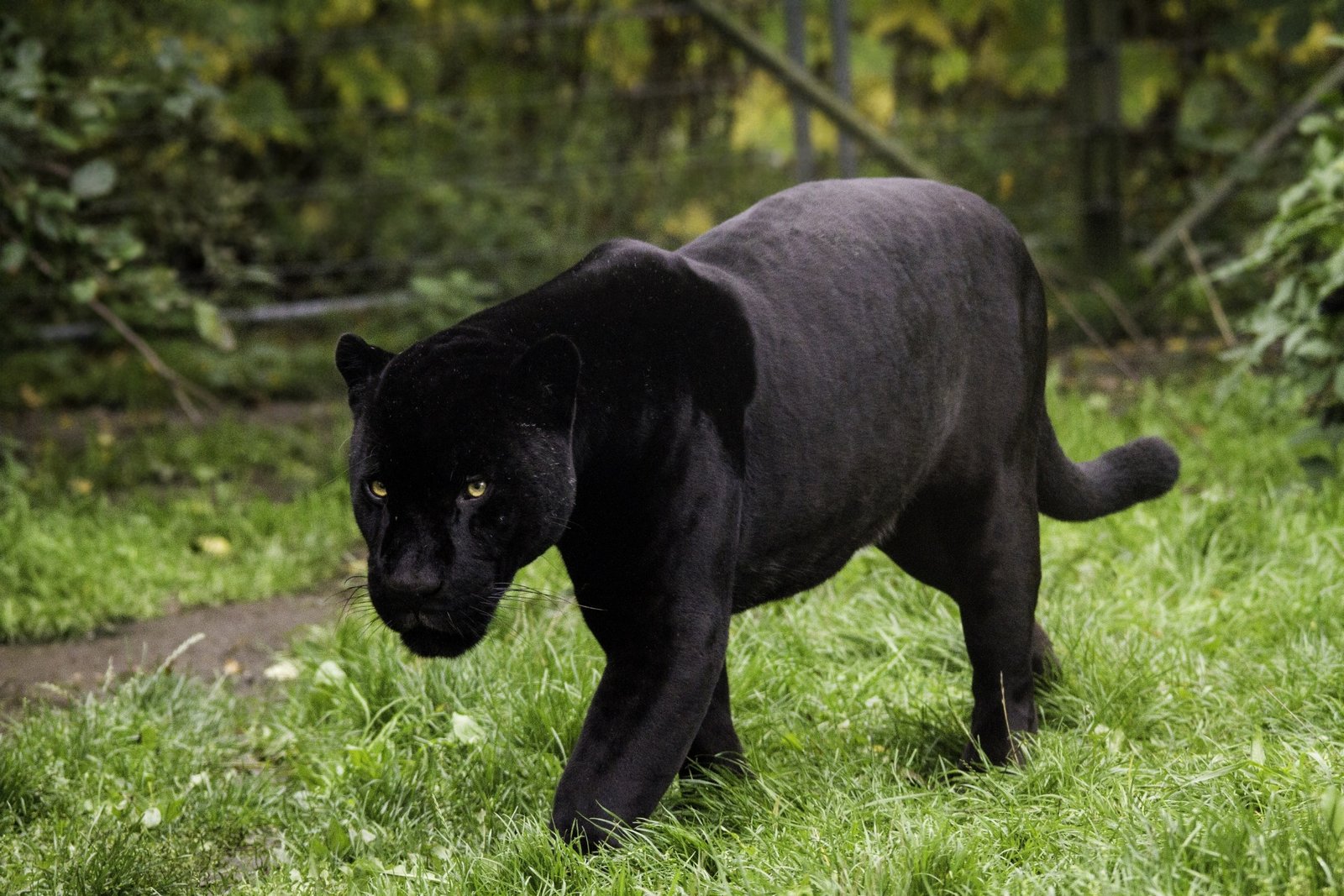Here are the top 10 Black Panther Facts For Kids which will provide you with a brief overview of this awesome cat.
- Black panther is a melanistic (black-pigmented) big cat.
- Black panthers have specific rosette patterns that are not visible due to their dark fur.
- A Black panther can be a leopard, jaguar & very rarely a tiger that has black fur.
- A leopard and jaguar black panthers have a speed of 58 km/h and 80 km/h, respectively.
- Black panthers are excellent and strongest tree climbers.
- A jaguar black panther can drag a bull that doubles its size in its jaws.
- Black panther leopards and jaguars are found in forests, grasslands, and wetlands.
- Black panthers are obligate carnivores.
- The black panther is the national animal of the African country Gabon.
- A black panther is also sometimes known as the ghost of the forest.
Black Panther Facts For Kids
What Is Black Panther – Black Panthers Definition
- Black panther is a term used for melanistic or black-pigmented color variants of any Panthera (big cat) species.
- However, this term is particularly used for black pigmented jaguars (Panthera onca) found in the Americas and leopards (Panthera padres) found in Asia and Africa. Understanding the intricate genetic factors underlying their melanistic appearance and the ecological dynamics shaping their populations provides invaluable insights into the natural world. Whether exploring their role as apex predators or their conservation status in diverse habitats, biology assignment help by EduBirdie could help you ravel the complexities of black panthers and their significance within ecosystems worldwide.
- Black panthers of both species have their specific spotted marking besides having excessively pigmented coats.
- They are the black morphs of their species and do not form any separate species.
- Their black color is due to genetics. The genetic allele that causes melanism (black pigmentation) is dominant in jaguars and recessive in leopards.
- Black panthers are less common than their normal counterparts. They are estimated to be only 11% of the leopard population and only 6% of the South American jaguar population.
- Black variant forms are also found in tigers, however, they are extremely rare as compared to leopards and jaguars.
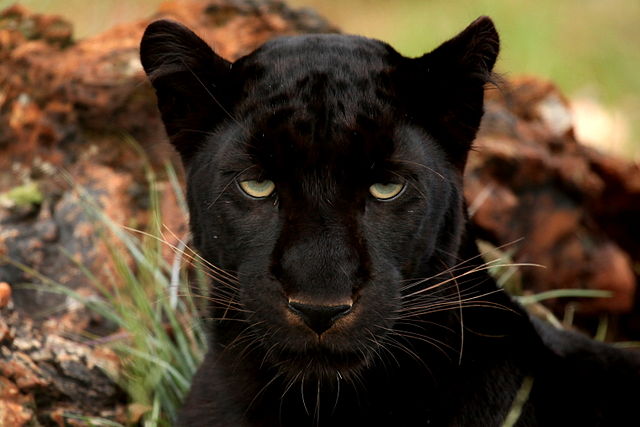
What Does Black Panther Mean – Black Panther Meaning
- Black Panther means melanistic (black-pigmented) big cat.
- This term is especially used for pigmented leopards and jaguars.
What Does A Black Panther Symbolize
- As a totem animal, the black panther symbolizes courage, strength, and power.
Black Panther Scientific Name
- The scientific name of black panther is;
- Panthera onca for jaguar
- Panthera pardus for leopard
Black Panther Classification – Black Panther Taxonomy
- The following is the scientific classification or taxonomy of black panther:
| Kingdom | Animalia |
| Phylum | Chordata |
| Sub-phylum | Vertebrata |
| Class | Mammalia |
| Order | Carnivora |
| Sub-order | Feliformia |
| Family | Felidae |
| Sub-family | Pantherinae |
| Genus | Panthera |
| Species | Panthera onca (jaguar) Panthera pardus (leopard) |
Where Do Black Panthers Come From – Black Panther Evolution
- Geographically, the most probable origin of the Panthera is northern Central Asia.
- The oldest known Panthera species is Panthera blytheae, whose skull features resemble that of the snow leopard.
- The divergence of Panthera from other cat species occurred around 11.3 million years ago.
- It then evolved into the species of leopard around 4.35 million years ago and into a jaguar about 1.5 million years ago.
- It is considered that the modern leopard evolved about 0.5 to 0.8 million years ago in Africa. About 0.3 to 0.2 million years ago, it then adaptively radiated across Asia.
- Jaguars probably entered the American continent through the Bering Strait Bridge or Beringia during the Early Pleistocene.
- Panthera onca augusta was its immediate ancestor, who was larger than the modern jaguars.
Black Panther Characteristics – Black Panther Features
- Besides black fur, the black panther jaguars and black panther leopards have the same characteristic as their normal counterparts.
- Like normal jaguars and leopards, black panther jaguars and leopards have their specific rosette patterns. However, it is not visible due to the dark color of their fur.
- A jaguar black panther has a stocky body, round head, strong square shape jaws, and extremely powerful legs.
- Black panther leopards also have muscular bodies, broadheads, and short limbs like their normal counterparts.
- Evidence shows that a dominant allele is responsible for melanism in jaguars. While in leopards, a recessive allele causes melanism.
- Like their normal counterparts, black panther jaguars are more robust than leopards. Of all the big cat species, the biting force of the jaguar is the third highest (after tiger and lion). A medium-sized adult jaguar can lonely drag a full-size bull in its jaws and can grind the heaviest bones.
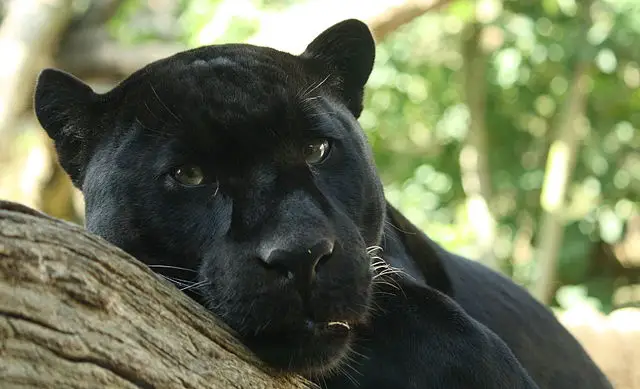
Black Panther Species – Types Of Black Panthers
- There are two types or species of black panthers;
- Panthera onca (jaguar)
- Panthera pardus (leopard)
What Does A Black Panther Look Like – Black Panther Appearances
How Tall Is Black Panther – Black Panther Height
- The average standing height of a black panther leopard is 60 to 70 cm (23.6 to 27.5 inches) at the shoulder region.
- In jaguar black panthers, the average standing height is from 63 to 76 cm (24.8 to 30.0 inches).
- The average height of black tigers is from 70 to 120 cm (27.5 to 47.2 inches).
How Big Is A Black Panther – Black Panther Size
- The average size of a black panther leopard is from 90 to 160 cm (0.9 to 1.6 meters).
- The average size of a black panther jaguar is from 120 to 200 cm (1.2 to 2.0 meters).
- The average size of the black tiger is from 250 to 390 cm (2.5 to 3.9 meters).
How Much Does A Black Panther Weigh – Black Panther Weight
- The average weight of an adult leopard black panther is up to 31 kg (68.3 pounds).
- The average weight of adult jaguar black panthers is from 56 to 96 kg (123.4 to 211 pounds).
- The weight range of adult black tigers is from 90 to 310 kg (198.4 to 683.4 pounds).
What Color Is A Black Panther – Black Panther Colors
- A black panther has shiny black or dark brown color.
What Color Eyes Do Black Panthers Have – Black Panther Eye Color
- Black panthers have green or emerald green color eyes.
Black Panther Teeth Facts
- Like other felids (big cats), black panthers have the following basic dental formula: “ (Incisors) 3/3; (Canine) 1/1; (Premolars) 3/2; (Molars) 1/1 = 30”.
- Like all felids, the premolar and molar teeth of black panthers have carnassial modification for shearing flesh.
- Their 3rd premolar has an interior cusp for crushing bones.
- They have large canine teeth that are enforced with strong masseter muscles. They use their canine teeth to kill prey, often only with a single lethal bite.
Black Panther Description
How Fast Is A Black Panther – Black Panther Speed
- Black panthers are fast animals and leopard and jaguar black panthers can run at speeds of 58 km/h and about 80 km/h, respectively.
- However, like other big cats, black panthers also have short stamina and can maintain their fast speed for only short distances.
How Fast Can A Black Panther Run
- A leopard black panther can run at the speed of 58 km/h (36 miles per hour).
- A jaguar black panther can run at a speed of about 80 km/h (50 miles per hour).
- A black tiger can run at the speed of 49 to 65 km/h (30 to 40 miles per hour).
Black Panther Jumping
- A leopard black panther can jump up to 3 meters (10 feet) high in the air and covers up to 6 meters (20 feet) distance in a single leap.
- The jumping height of a jaguar black panther is also 3 meters (10 feet) off the ground.
Can Black Panthers Swim – Black Panther Swimming Facts
- Yes, both jaguar and leopard black panthers can swim.
- Both jaguar and leopard black panthers are excellent swimmers.
- The exact swimming speed of leopard black panthers is unknown, however, it is believed that they swim at the speed of 15 km/h just like their normal counterparts.
- Jaguar black panthers are extremely good swimmers and love to live near water. They are known for crossing long rivers.
- During swimming, black panthers use their limbs and tail to propel their body through water.
- They swim for hunting fish and other animals found in water, and for crossing rivers.
Do Black Panthers Climb Trees – Black Panthers Climbing Facts
- Yes, black panthers climb trees.
- Black panthers are excellent and strongest tree climbers.
- They are observed pouncing on the prey from a tree.
- They use their strong paws for climbing, while their sharp claws provide them a strong grip on the tree.
- To climb down from a tree, they descend in head-first position.
- Leopard black panthers usually choose tree branches to rest during the daytime. They sometimes also carry their kills up in the tree probably to ensure that it would not be stolen.
- Climbing ability is one of the special adaptations of the black panthers, as some of their prey inhabit the canopy layer of the forest.
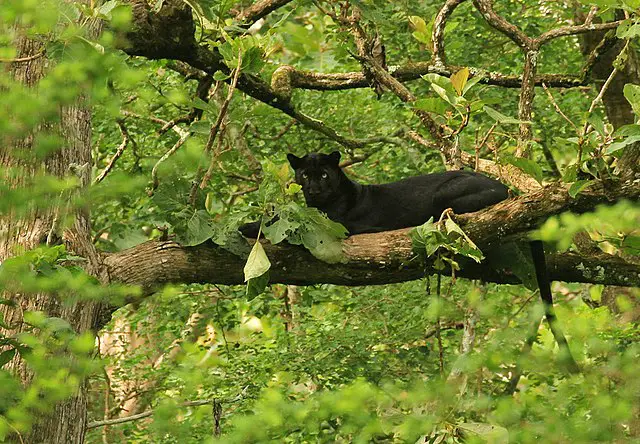
How Strong Is Black Panther – Black Panther Strength
- Black panthers are extremely strong animals.
- A jaguar black panther is strong enough to individually drag a bull (double its size) in its jaws.
- The biting force of a 100 kg jaguar black panther is up to 4.939 kilonewtons at its canine teeth and 6.922 kilonewtons at its carnassial notch. In its jaws, they can crush the heaviest bones and the shells of armored turtles and other reptiles.
- A leopard black panther is strong enough to climb a tree while dragging up heavy prey in its jaws.
What Does A Panther Sound Like – Black Panther Sound
- Black panthers make a variety of sounds that includes roaring, hissing, and growling.
Where Do Black Panthers Live – Black Panther Animal Habitat Facts
- Like normal leopards and jaguars, black panther leopards and jaguars live in forests, grasslands, and wetlands.
- Black panther leopards are chiefly found in the dense and hot tropical rainforests of South and Southeast Asia. Their habitat range is much larger and includes rainforests, savannahs, and regions with undisturbed woodlands, grasslands, and riverine forests.
- Jaguar black panthers are found in the rain forests and cloud forests of South and Central America. They are also found in the seasonally flooded open wetlands, as well as dry grasslands. They typically avoid mountain forests and prefer to live in dense rainforests with cover (where they can stalk for prey) and nearby water, such as swamps and rivers. Besides their preferred habitat, they are also found in deserts and scrublands.
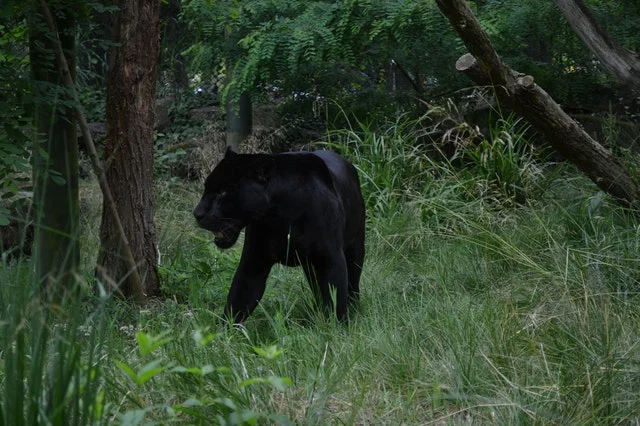
Where Do Black Panthers Live In The World
- In the world, leopard black panthers are found in South and Southeast Asia and Africa. Like normal leopards, the geographic range of the black panther leopards also covers sub-Saharan Africa, northeast Africa, parts of Western and Central Asia, the Indian subcontinent, and Southeast and East Asia.
- Jaguar black panthers live in the rainforests of South and Central America. Like normal jaguars, their habitat range covers countries including Argentina, Brazil, Bolivia, Columbia, Ecuador, Costa Rica, Guatemala, French Guiana, Guyana, Nicaragua, Honduras, Panama, Paraguay, Peru, Suriname, Venezuela, and the United States.
Black Panther Natural Habitat
- The natural habitat of black panther leopard includes rainforests, grasslands, woodlands, deserts, deciduous and other forests, savannah, mountain habitats, shrublands, coastal scrubs, and swampy regions.
- The natural habitat of jaguar black panthers includes rainforests, thick tropical forests, coastal mangroves, swamps, grasslands, lowland river valleys, and mixed conifer forests. They prefer to live near water streams and rivers.
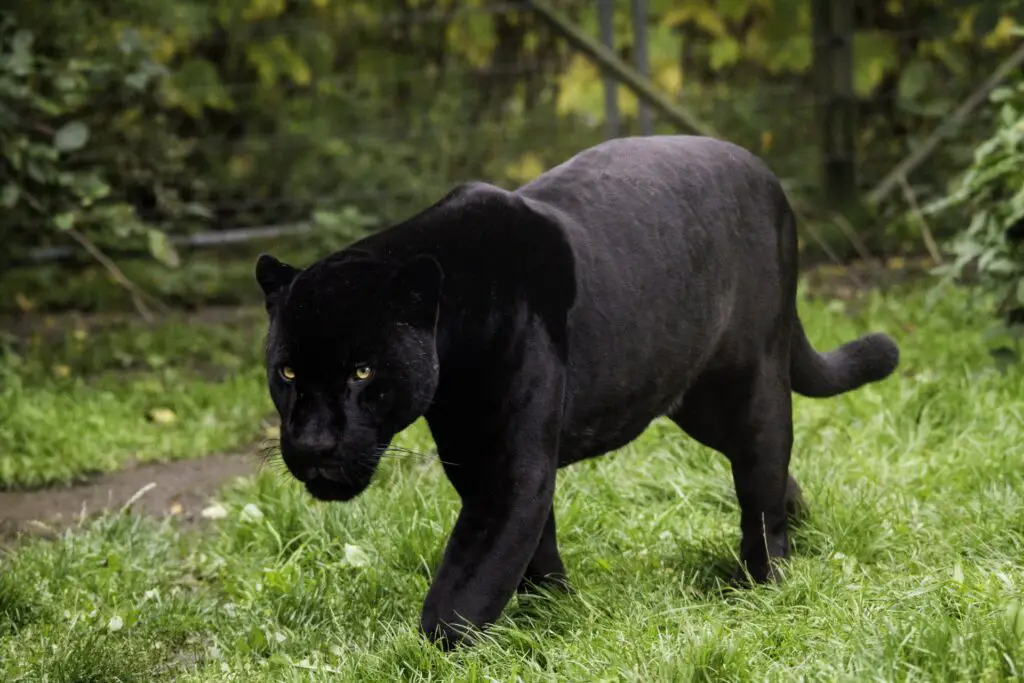
Black Panthers In Captivity
- It is unknown how many black panthers are there in captivity.
- A melanistic jaguar is living at Henry Doorly Zoo in Omaha, Nebraska, USA.
- There is also a black panther in the Bronx Zoo, New York, USA.
How Long Do Black Panthers Live – Black Panther Lifespan – Black Panther Age
- Black panther leopards and jaguars live longer in captivity as compared to the wild, just like their normal counterparts.
Black Panther Lifespan In Wild
- The lifespan of black panther leopard in the wild is 12 to 17 years, and of black panther, the jaguar is 12 to 15 years.
Black Panther Lifespan In Captivity
- Black panther leopards and jaguars do well in captivity like their non-melanistic counterparts.
- The average estimated lifespan of both leopard and jaguar black panthers in captivity is up to 20 years.
Black Panther Life Cycle
- The lifecycle of black panthers starts when they become sexually mature.
- Female black panthers of both jaguar and leopard species become mature at the age of only 2 years, while male individuals of both species take 3 to 4 years to become mature.
- The average size of a litter is 2 to 3 cubs.
- Mothers raise their cubs for about 3 to 3.5 months.
- The average lifespan of jaguar and leopard black panthers in the wild is 12 to 15 and 12 to 17 years, respectively.
What Do Black Panthers Eat – Black Panther Diet – Black Panther Diet In Wild
- Like other big cats, black panthers are obligate carnivores, which means they fulfill all their nutritional requirements by only eating the meat of other animals.
- Leopard black panthers prefer to eat ungulates, such as bushbuck, impala, common duiker, and chital. They also eat primate species of several genera found in their habitat range, such as white-eyelid mangabeys (Cercocebus), grey langur (Semnopithecus), and guenons (Cercopithecus). They also eat small carnivores, like a bat-eared fox, black-backed jackal, cheetah, and genet. They also eat several species of antelopes and deers found in their habitat. In regions where large carnivores (lions and tigers) are lacking, they are observed hunting giraffes. When the main prey species are scarce, leopard black panthers then opportunistically eat rodents and other small animals. They fulfill much of their water requirements from the body fluids of the prey and by eating succulent plants, such as gemsbok cucumbers, tsamma melon, and Kalahari sore grass. They drink water after every two to three days.
- The diet of jaguar black panthers encompasses at least 87 species of animals. They prefer to prey on animals of 45 to 85 kg weight. Their most preferred preys are giant ant-eaters and capybara. The prey species they commonly eat include wild boar, collared peccary, common caiman, deer, nine-banded armadillo, white-nosed coati, frogs, and fish. Unlike other big cats, jaguar black panthers do not prefer to prey on even-toed ungulates.
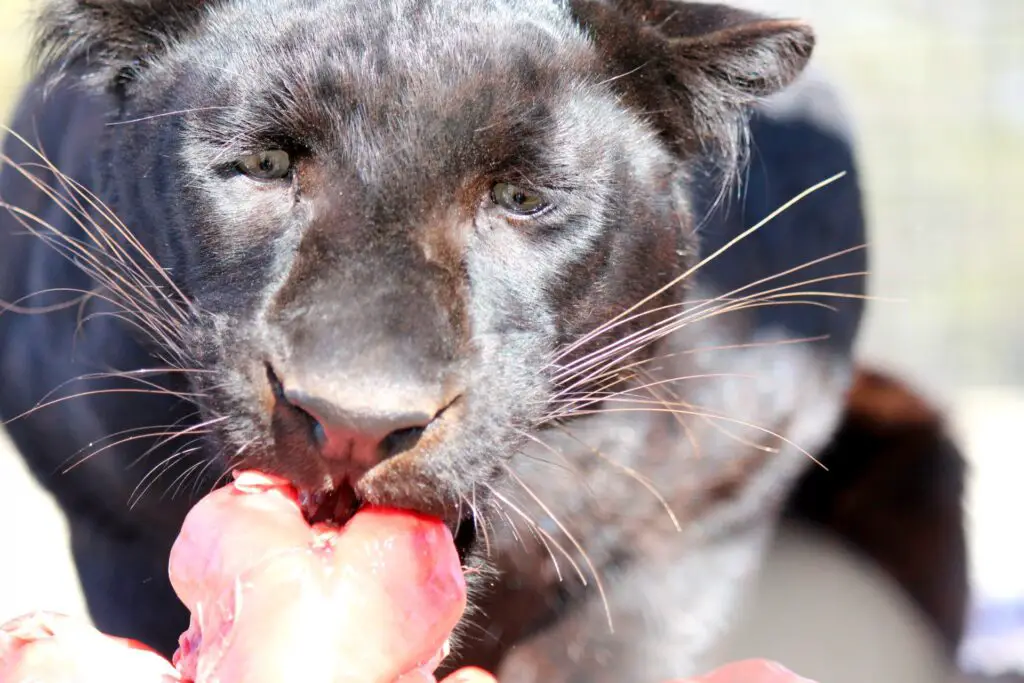
Black Panther Diet In Captivity
- In captivity, black panthers are fed meat.
- The recommended daily amount of meat for a captive black panther of 50 to 60 kg weight range is only 2 kg.
What Do Black Panthers Eat In The Rainforest
- In the rainforest, black panthers (both leopards and jaguars) eat a lot of animal species.
- They eat ungulates, monkeys, other small carnivores, rodents, rabbits, frogs, fish, and reptiles.
How Do Black Panthers Reproduce – Black Panther Reproduction
- Like other mammals, black panthers reproduce sexually.
- Female individuals of both leopard and jaguar species mature at the age of about 2 years while males mature at the age of 3 to 4 years.
- Like their normal counterparts, black panthers have no specific season for mating and mate year around.
- The gestation period of both species is 90 to 105 days.
- Females give birth in a den or cave.
- The interbreeding of leopard black panthers is reported to produce a smaller litter size as compared to the normal leopards.
- The average size of a litter is 2 to 4 cubs in both species, while the most common size of a litter is 2.
- The females raise the cubs and feed them with their milk for about 3 months.
Baby Black Panther Facts
What Is A Baby Black Panther Called
- A baby black panther is called a cub.
- Baby black panthers of both leopard and jaguar species are known as cubs.
- They are born weak and blind after the gestation period of 90 to 105 days.
- The cubs start opening their eyes after 7 to 9 days of their birth.
- They depend on their mother for food and protection.
- They are weaned at the age of three months, however, remain in the birth den for about six months of their age.
- After the age of six months, the cubs start joining their mother on the hunt.
- During the first year of life, the estimated mortality rate of leopard black panther cubs is 41 to 50%.
- The cubs remain with their mother for about 2 years and then leave to establish their new territories.
Do Black Panthers Have Predators
- Black panthers exist on the top of the food chain and have no natural predators.
- However, large carnivore animals such as lions sometimes prey and eat small black panthers.
What Are Black Panthers Predators – Black Panther Predators
- Large carnivores, such as lions, tigers, and hyenas, sometimes prey on small individuals of black panthers.
- Some crocodile species, such as Nile crocodile and Mugger crocodile, are observed killing black panthers.
- Human beings are the biggest predators of black panthers.
What Animals Eat Black Panthers
- Lions, tigers, crocodiles, and hyenas are the major animal species that eat black panthers.
Why Are Black Panthers Going Extinct
- Like their normal counterparts, black panthers are going to become locally extinct in some regions.
- The major reasons for their local extinction are excessive hunting for fur, loss of habitat, and unavailability of prey.
Are Black Panthers Endangered – Why Are Black Panthers Endangered
- No, black panthers of both jaguar and leopard species are not Endangered.
- However, there are many threats to their survival. Some of the major threats are:
- Loss of habitat due to deforestation and other human activities
- Conflicts with humans, as they sometimes attack the livestock
- Illegal hunting for the fur trade
- Climate change, which causes the unavailability of their prey

Black Panther Population – How Many Black Panthers Are Left In The World
- It is estimated that there are about 15,000 to 30,000 black leopards (11% of the whole leopard population) left in the world.
- The estimated 2020 population of black jaguars are only 600 individuals (6% of the total jaguar population).
- It is unknown how many black leopards of jaguars are found in captivity.
Black Panther Conservation Status
- The conservation status of the jaguar is Near Threatened on the IUCN Red List. So the conservation status of jaguar black panthers is also Near Threatened.
- While the conservation status of leopards on the IUCN Red List as Vulnerable. So it is also the conservation status of leopard black panthers.
Why Is Black Panther Important
- Black panthers are important just like their non-melanistic counterparts.
- They play an important ecological role to control and regulate the populations of their prey and shaping animal communities.
- Black panthers are apex predators and mostly eat herbivore animals.
- In their habitat, they play a wide role to keep the population of herbivore animals in control, which is necessary for the growth and maintenance of forests.
- In such a way, they indirectly preserve plant life in their habitat.
Are Black Panthers Dangerous To Humans
- Black panthers are not dangerous to humans.
- Humans are not included in their menu.
- They are solitary animals and usually avoid people and human-populated regions.
- However, they would attack humans if they feel threatened.
Fun Facts About Black Panthers
- A black panther is also sometimes known as the ghost of the forest.
- Black panthers are excellent swimmers and climbers.
- Black panthers are stealthy hunters. Their black fur provides them excellent camouflage in dense forests.
- They are solitary creatures and socialize only for mating.
- They have good senses of hearing and vision.
Interesting Facts About Black Panthers
- The black panther is the national animal of the African country Gabon.
- Black panther is not a separate species of big cats. They are the black variant forms of leopard and jaguar species.
- The black color of the skin and fur of the black panthers is due to genetics. In leopards, the expression of recessive melanistic allele causes black color, while in jaguars, the expression of dominant melanistic allele causes black color.
- The excessive black pigmentation of black panthers hides their specific rosette pattern, due to which their rosette pattern is known as “ghost rosettes”.
- Black panthers are found on different continents. As they belong to different species (leopard and jaguar), they are found in the continents of Asia, Africa, and the Americas.
- Melanistic individuals are less common as compared to normal ones. In leopards, the melanistic variants are estimated as only about 11% of the whole population. While melanistic jaguars are estimated as only about 6% of the South American jaguar population.
- As the melanistic (black-pigmented) gene is dominant in jaguars, so a pair of melanistic jaguars may produce black cubs, while a pair of normally spotted jaguars may produce only normal spotted cubs.
- Apart from having black color fur, black panthers are believed to be less fertile (have small litter size), more aggressive, and unpredictable than their normal counterparts.
To honor this mysterious and fascinating animal, you can use Custom Luggage Tags.
The surface of the custom luggage tags can be printed with exquisite black panther patterns, with smooth lines and realistic colors, showing the majesty and mystery of the black panther. The back of the luggage tag can be customized with personal information, making your luggage more eye-catching during the journey and less likely to be lost.
Whether at the airport, train station, or hotel, this black panther custom luggage tag can make your luggage stand out and become a beautiful landscape during the journey.

